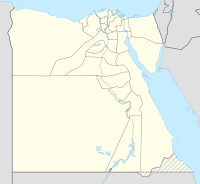This is an old revision of this page, as edited by A. Parrot (talk | contribs) at 16:20, 4 January 2023 (→Goshen in Egypt: Josephus is a primary source and was probably reporting Jewish folklore of his own time, which isn't relevant to this article page. All this section should do is summarize what Genesis says about Goshen.). The present address (URL) is a permanent link to this revision, which may differ significantly from the current revision.
Revision as of 16:20, 4 January 2023 by A. Parrot (talk | contribs) (→Goshen in Egypt: Josephus is a primary source and was probably reporting Jewish folklore of his own time, which isn't relevant to this article page. All this section should do is summarize what Genesis says about Goshen.)(diff) ← Previous revision | Latest revision (diff) | Newer revision → (diff) Place in Egypt given to the Hebrews by the pharaoh of Joseph30°52′20″N 31°28′39″E / 30.87222°N 31.47750°E / 30.87222; 31.47750

The land of Goshen (Template:Lang-he, Modern: ʾEreẓ Gōšen, Tiberian: ʾEreṣ Gōšen) is named in the Hebrew Bible as the place in Egypt given to the Hebrews by the pharaoh of Joseph (Book of Genesis, Genesis 45:9–10), and the land from which they later left Egypt at the time of the Exodus. It is believed to have been located in the eastern Nile Delta, lower Egypt; perhaps at or near Avaris, the seat of power of the Hyksos kings.
Meaning of the name
If the Septuagint reading "Gesem" is correct, the word, which in its Hebrew form has no known meaning, may mean "cultivated"—comparing the Arabic root j-š-m, "to labor". Egyptologists have suggested a connection with the Egyptian word qis, meaning "inundated land". Because Goshen was apparently the same region, called by the Greeks the "Arabian nome," which had its capital at Phakousa. The name represented the Egyptian Pa-qas (Brugsch, Geog., I, 298), the name of a town, with the determinative for "pouring forth". Donald Redford, while not disputing the location of Goshen, gives a different origin for the name, deriving it from "Gasmu," the rulers of the Bedouin Qedarites who occupied the eastern Delta from the 7th century BCE, but John Van Seters thinks this unlikely.
Goshen in Egypt
GoshenAccording to the Joseph narrative in the Book of Genesis, the sons of Jacob (Israel) who were living in Hebron, experienced a severe famine that lasted for seven years. Word was that Egypt was the only kingdom able to supply food, and thus the sons of Jacob (Israel) journeyed there to buy goods. In the second year of famine, the Vizier of Egypt, Joseph, invited the sons of Israel to live in Egyptian territory. They settled in the country of Goshen. Goshen is described as the best land in Egypt, suitable for both crops and livestock. It has been suggested that this location may have been somewhat apart from Egypt, because Genesis 46:34 states, "Ye may dwell in the land of Goshen; for every shepherd is an abomination unto the Egyptians." After the death of Joseph and those of his generation, the following generations of Israelites had become populous in number. The Egyptians feared potential integration or takeover, so they enslaved the Israelites.
Four hundred thirty years later, to the day, Moses led the Israelites out of Egypt, from Goshen (Ramesses) to Succoth, the first waypoint of the Exodus. They pitched at 41 locations after initially crossing the Nile Delta to the east, and then also crossing the Red Sea, to the last station being the "plains of Moab".
Identification

In 1885, Édouard Naville identified Goshen as the 20th nome of Egypt, located in the eastern Delta, and known as "Gesem" or "Kesem" during the Twenty-sixth dynasty of Egypt (672–525 BCE). It covered the western end of the Wadi Tumilat, the eastern end being the district of Succoth, which had Pithom as its main town, extended north as far as the ruins of Pi-Ramesses (the "land of Rameses"), and included both crop land and grazing land.
References
- "www.Bibler.org - Dictionary - Goshen". 2012-10-08.
- Donald Redford, "Perspective on the Exodus", pp.139-140, quoted in John Van Seters, "The Geography of the Exodus," in Silberman, Neil Ash (editor), The Land That I Will Show You: Essays in History and Archaeology of the Ancient Near East in Honor of J. Maxwell Miller (Sheffield Academic Press, 1997) fn.37, p.269
- Genesis 45:11
- Genesis 46:34,47:27
- Exodus 12:40
- Numbers 33:5
- numbers 22:1,33:48–50
- John Van Seters, "The Geography of the Exodus," in Silberman, Neil Ash (editor), The Land That I Will Show You: Essays in History and Archaeology of the Ancient Near East in Honor of J. Maxwell Miller (Sheffield Academic Press, 1997) pp. 267–269, ISBN 978-1850756507
External links
- Macalister, R. A. Stewart (1911). "Goshen, a division of Egypt settled by the Israelites between Jacob's immigration and the Exodus" . Encyclopædia Britannica (11th ed.).
